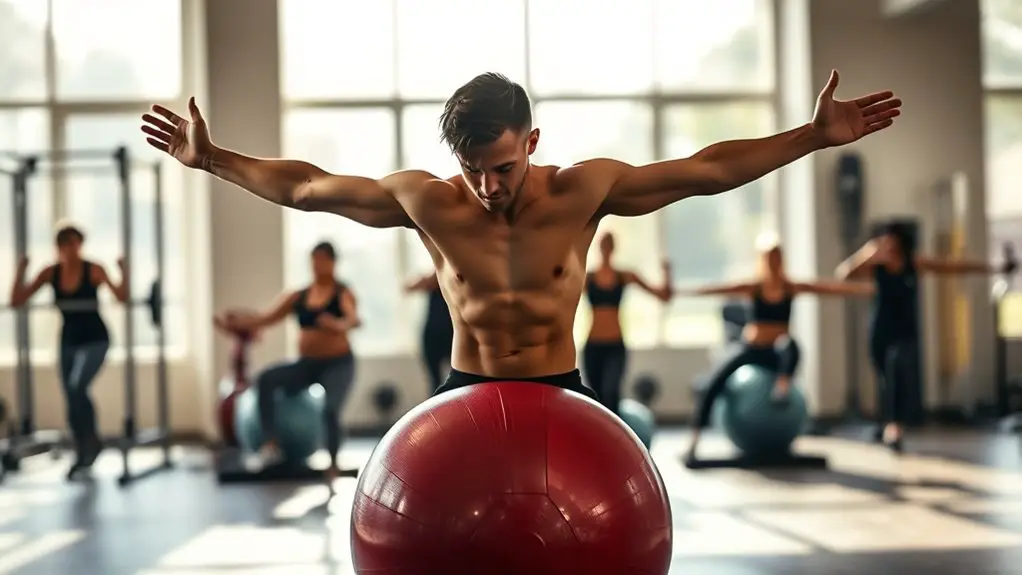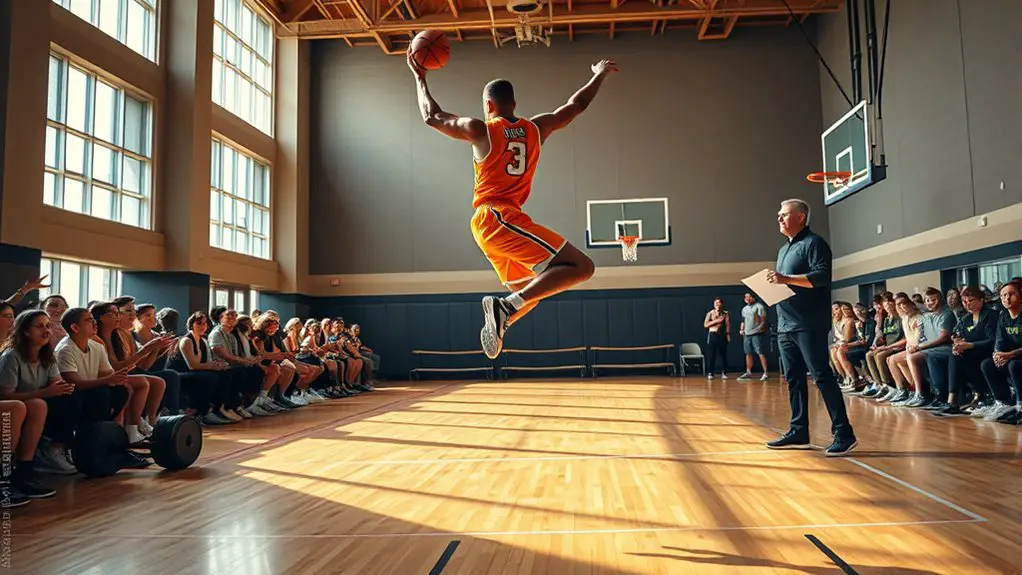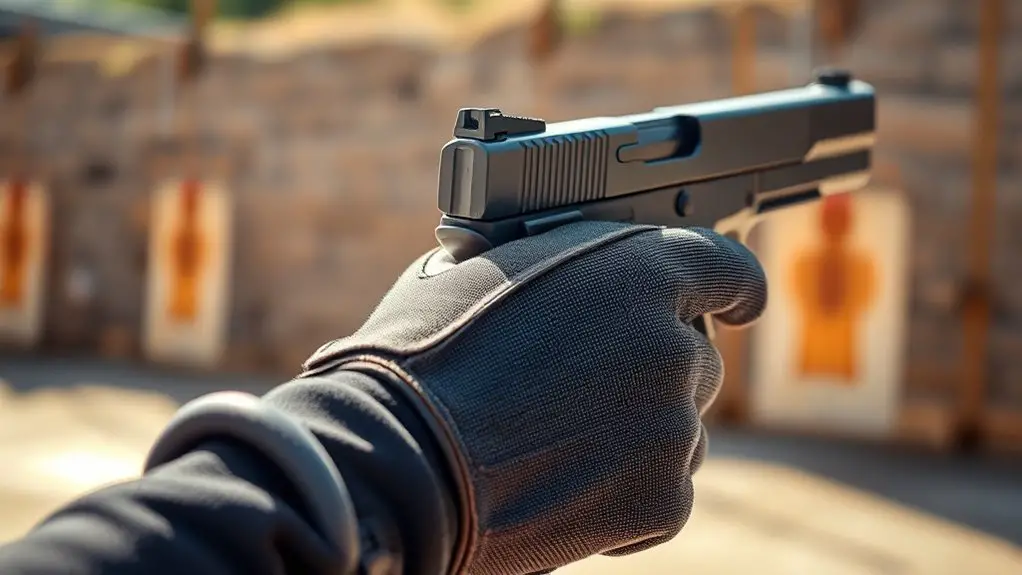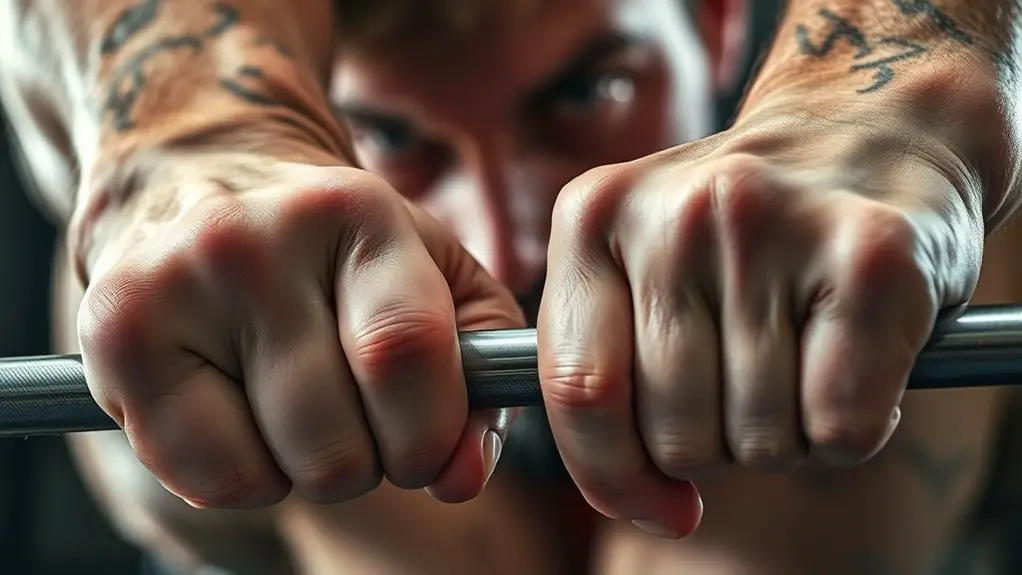To enhance your shooting posture, focus on core workouts like plank variations for stability, medicine ball exercises for rotational power, and leg raises to improve core endurance. Incorporating stability ball workouts can also boost your balance and coordination. Don't forget dynamic core exercises like bird-dogs and plank jacks to improve agility and flexibility. These workouts will help you maintain a steady shot and improve your overall performance. There's more to explore about integrating these exercises effectively into your routine.
Understanding the Importance of Core Strength for Shooting Accuracy
When you consider the mechanics of shooting, it's clear that core strength plays an essential role in maintaining stability and accuracy. Your core acts as the foundation for your entire body, helping you control your movements and absorb any unexpected shifts. Without a strong core, you'll struggle to keep your posture steady, and that can directly impact your shooting accuracy. Imagine taking a shot and feeling your body sway; it's not just frustrating, it can lead to missed targets. A well-conditioned core helps prevent injuries by stabilizing the spine during exertion, allowing for more controlled and precise shooting.
Plank Variations for Core Stability
To build a strong core for steady shooting, mastering plank variations is essential. You'll want to focus on the standard plank technique, explore the benefits of the side plank, and try the plank to push-up changeover. Each variation targets different muscle groups and enhances your overall stability. Incorporating mobility training into your routine can further improve your range of motion, supporting better shooting posture.
Standard Plank Technique
Plank variations are often overlooked yet essential for building core stability, which directly impacts your shooting posture. Mastering the standard plank can enhance your performance. Here's how to nail it:
- Plank Alignment: Keep your body in a straight line from head to heels. Avoid sagging your hips or arching your back.
- Elbow Position: Place your elbows directly under your shoulders to distribute weight evenly.
- Feet Placement: Position your feet hip-width apart for better balance and stability.
- Breathing Technique: Breathe steadily through your nose and out through your mouth, maintaining control and focus.
Side Plank Benefits
One powerful variation that can considerably enhance your core stability is the side plank. This exercise not only strengthens your obliques but also improves balance and posture, allowing you more freedom in movement. You can tweak your routine with side plank variations and modifications to match your fitness level. Here's a quick overview:
| Variation | Benefits | Modifications |
|---|---|---|
| Classic Side Plank | Strengthens core and hips | Drop a knee for support |
| Side Plank Dip | Engages more muscle groups | Hold higher on a block |
| Side Plank Twist | Enhances stability and mobility | Use a wall for balance |
Incorporating these variations into your workouts will empower you to achieve a steadier shooting posture while enjoying the journey toward fitness freedom.
Plank to Push-Up
Building on the core stability gained from side planks, the plank to push-up variation is an excellent way to further challenge your strength and balance. This dynamic movement not only enhances core stability but also offers incredible push-up benefits. Here's how to do it:
- Start in a high plank position, keeping your body straight.
- Lower yourself into a push-up, engaging your core.
- Push back up to the plank position.
- Repeat for several reps, focusing on control.
Incorporating this plank variation into your routine can boost your overall stability, improve your posture, and empower your body for greater freedom of movement. Feel the strength build and embrace the challenge!
Medicine Ball Exercises for Rotational Power
When it comes to enhancing your shooting skills, developing rotational power is key. Medicine ball exercises can greatly boost your core strength and improve your overall performance. Let's explore some effective movements that can help you harness this power. Incorporating Olympic lifts into your training routine can also enhance your explosive strength, further contributing to your shooting capabilities.
Benefits of Rotational Power
Since developing rotational power is essential for maintaining a steady shooting posture, incorporating medicine ball exercises into your routine can yield significant benefits. Here's how enhancing your rotational strength can boost your game:
- Improved Stability: Strengthening your core supports better balance during shots.
- Enhanced Power Development: Rotational power translates into explosive movements on the court.
- Injury Prevention: A strong core stabilizes your spine, reducing the risk of injuries.
- Greater Control: Increased rotational strength allows for more precise shot placement.
Key Medicine Ball Movements
Incorporating just a few key medicine ball movements into your training can greatly enhance your rotational power and overall shooting posture. One powerful exercise is the medicine ball slam. As you lift the ball overhead and slam it down, you engage your core and build explosive strength. This movement not only improves your power but also reinforces your stability.
Another vital exercise is the medicine ball twist. By rotating your torso while holding the ball, you'll boost your rotational strength, essential for maintaining balance during shots. These dynamic movements create a strong foundation for your shooting game, allowing you to move freely and confidently. So, grab that medicine ball and release your potential!
Leg Raises and Their Impact on Core Endurance
Leg raises serve as a powerful exercise for enhancing core endurance, vital for maintaining steady shooting posture. By incorporating leg raises into your routine, you're not just sculpting your abs; you're building the foundation for freedom in your movements. Here's how they impact your core endurance:
- Engage Multiple Muscle Groups: Leg raises target your lower abs, hip flexors, and obliques.
- Increase Stability: A strong core stabilizes your body, allowing for fluid shooting motions.
- Boost Flexibility: They promote flexibility in your hips, which is important for dynamic movement.
- Enhance Control: Improved core endurance translates to better control over your body during shooting.
When you embrace leg raises, you're investing in your overall performance. Your core endurance will improve, helping you maintain that steady shooting posture you desire. Additionally, incorporating compound movements into your training can further enhance your functional strength. So, let's get started and feel the freedom in your game!
Stability Ball Workouts for Balance and Coordination
Stability ball workouts are an excellent way to enhance your balance and coordination, vital for maintaining a steady shooting posture. By incorporating stability balls into your routine, you'll experience numerous stability ball benefits that improve your core strength and overall body awareness. These workouts challenge your body to engage stabilizing muscles, giving you that freedom of movement that's essential for athletes. Additionally, engaging in mobility work can further improve your joint function and decrease injury risk, complementing your stability ball exercises.
Start with simple exercises like wall squats or seated ball bounces to kick off your balance training. As you progress, try more dynamic moves, such as ball roll-outs or planks with your feet on the ball. These exercises not only bolster your core but also sharpen your coordination, allowing you to move fluidly on the court.
Dynamic Core Exercises for Agility and Flexibility
While maintaining agility and flexibility is essential for athletes, dynamic core exercises can greatly enhance these attributes. By incorporating dynamic stretching into your routine, you can improve core mobility and boost your performance. Here are four dynamic core exercises to reflect on:
- Bird-Dog: Start on all fours, extend one arm and the opposite leg, then switch. This promotes balance and coordination.
- Medicine Ball Slams: Lift a medicine ball overhead and slam it down, engaging your core while improving power and stability.
- Lateral Lunges with Reach: Step to the side into a lunge while reaching the opposite arm overhead, enhancing flexibility and core strength.
- Plank Jacks: From a plank position, jump your feet out and in. This dynamic movement activates your core while building agility.
Incorporating these exercises into your routine not only enhances your core strength but also supports improved flexibility which is crucial for athletic performance. Embrace these exercises to release your potential and enjoy the freedom that comes with enhanced agility and flexibility!
Incorporating Core Workouts Into Your Training Routine
To enhance your athletic performance, it's important to integrate core workouts into your training regimen. A strong core stabilizes your body, allowing for better shooting posture and overall agility. Start by selecting a few core workout routines that resonate with you—think planks, Russian twists, or bicycle crunches.
Make sure to balance your training frequency; aim for core workouts two to three times a week. This keeps your core engaged without overloading it. Mix these routines into your existing schedule, perhaps as a warm-up or cool-down.
Don't forget to listen to your body; if you feel fatigued, adjust your intensity or take a rest day. The goal is to create a routine that feels liberating, not burdensome. By incorporating core workouts regularly, you'll not only enhance your shooting stability but also enjoy the process of becoming a more well-rounded athlete. Additionally, building core strength can significantly improve your power and endurance during sports activities.
Frequently Asked Questions
How Often Should I Perform Core Workouts for Best Results?
To achieve the best results, you should aim for a core workout frequency of three to four times a week. This ideal training schedule allows your muscles to recover while still challenging them regularly. You'll find that consistency is key, so listen to your body and adjust the intensity as needed. Remember, it's about progress, not perfection, so enjoy the journey and embrace the freedom that comes with building a strong core!
Can Core Workouts Prevent Injuries During Shooting?
Yes, core workouts can definitely help with injury prevention during shooting. By focusing on core stability, you're building a strong foundation that supports your movements. This strength reduces the risk of strain and fatigue, allowing you to shoot more freely and confidently. When your core is stable, you'll find it easier to maintain proper form, which is essential in avoiding injuries. So, keep those core workouts in your routine for better performance and safety!
What Are the Signs of a Weak Core?
"You can't build a strong house on a weak foundation." If you notice core instability, like difficulty maintaining balance or frequent back pain, it's a sign your core strength might be lacking. You might struggle with everyday movements or feel fatigued more quickly during physical activities. These signs indicate that it's time to strengthen your core, empowering you to move freely and confidently in all aspects of your life.
Do I Need Equipment for Effective Core Workouts?
You don't need fancy equipment for effective core workouts. Bodyweight exercises like planks and mountain climbers can build strength and stability, giving you that freedom to move without restrictions. Stability training is key, and you can achieve it using just your body. Embrace the simplicity of these movements; they help you develop a strong core without the hassle of gym gear. Just focus on proper form, and you'll see results in no time!
How Long Should I Hold Each Plank Position?
When you're holding a plank, imagine feeling strong and balanced, like a sturdy tree standing tall. For most plank variations, you should aim for 20 to 60 seconds. If you're just starting, try shorter durations and gradually increase as you gain strength. Listen to your body; plank duration varies for everyone. Focus on quality over quantity to feel that freedom and stability in your movements, empowering your core with each hold.




